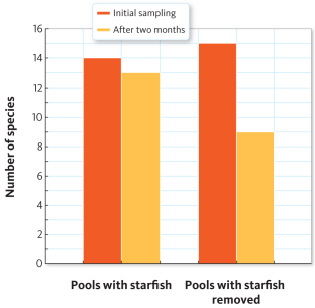Robert Paine was the first biologist to use the term keystone species in the 1960s. He was studying food webs in the rocky, intertidal pools in the Pacific Northwest. At one of his study sites, the dominant organisms in the tidal pools were mussels, barnacles, whelks, and a species of starfish known as Pisaster ochraceus . To examine the relationship between these species, Paine set up an experiment. In one area, he removed all the starfish from the tidal pools, and in an adjacent area, he left the tidal pools as he found them. Prior to removing the starfish, he sampled all the organisms in each pool. After two months, he repeated this sampling. A summary of his results is illustrated in the graph below.
Based on these results, would you consider the starfish to be a keystone predator?
Definitions:
Directly
in a straightforward or immediate manner.
Populations
Groups of individuals belonging to the same species that live in the same geographical area and have the capability of interbreeding.
Clumped Dispersion
A distribution pattern of organisms within a population where individuals are found in tight groups, influenced by social behavior or resource availability.
Population Dispersion
The way individuals within a population are spaced across their habitat, which can be categorized as uniform, random, or clumped according to patterns of spacing.
Q12: Water molds have cell walls made of<br>A)
Q12: Which of the following correctly lists the
Q19: The lighter, nonpitted surface areas of the
Q19: Lactose intolerance in humans is the inability
Q25: <img src="https://d2lvgg3v3hfg70.cloudfront.net/TBX9190/.jpg" alt=" In the accompanying
Q26: The process of applying surfaces to a
Q29: All of the following are inputs to
Q34: In humans, there are tiny mites called
Q35: _ are the structural and functional units
Q39: If you have eaten chicken, you know